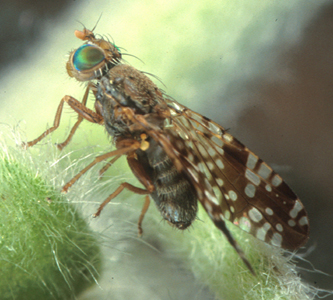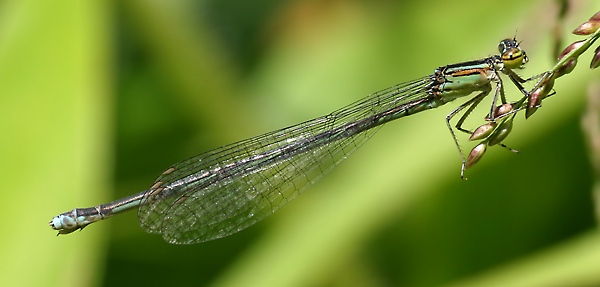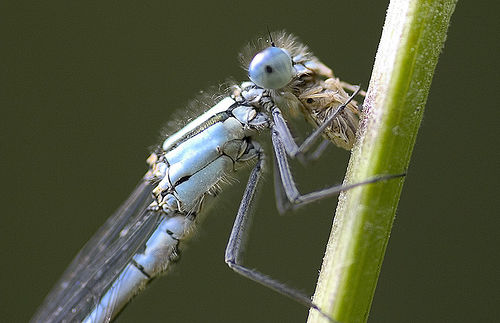Nutrition
Adult Damselflies:
 These predatory insects are not nearly as agile or strong
as their suborder counterparts, the dragonflies, but they do
have swift methods of capturing prey. Although
dragonflies and damselflies often live in the same littoral
areas, they do not compete for food because of their size
difference.
Damselfly
adults will focus on organisms that recently emerge from an
aquatic life stage because the organisms are more vulnerable
at this stage. Diptera is a common food choice for
damselflies because diptera are small enough for the
damselflies to handle. However, size
is not the only deterrent for damselflies; if the potential
prey has a stinger or sends chemical repellants, then the
damselfly is unlikely to pursue the chase.
These predatory insects are not nearly as agile or strong
as their suborder counterparts, the dragonflies, but they do
have swift methods of capturing prey. Although
dragonflies and damselflies often live in the same littoral
areas, they do not compete for food because of their size
difference.
Damselfly
adults will focus on organisms that recently emerge from an
aquatic life stage because the organisms are more vulnerable
at this stage. Diptera is a common food choice for
damselflies because diptera are small enough for the
damselflies to handle. However, size
is not the only deterrent for damselflies; if the potential
prey has a stinger or sends chemical repellants, then the
damselfly is unlikely to pursue the chase.
 A popular hunting method for damselflies requires low
amounts of energy because the damselfly slowly patrols its
habitat, waiting for suitable prey resting on littoral
plants or flying calmly. To capture small, flying
insects, the damselfly sweeps its forelegs through the air,
and the small insects are caught in the spine-like setae.
The prey is swept into the damselfly’s mouth where digestion
begins.
A popular hunting method for damselflies requires low
amounts of energy because the damselfly slowly patrols its
habitat, waiting for suitable prey resting on littoral
plants or flying calmly. To capture small, flying
insects, the damselfly sweeps its forelegs through the air,
and the small insects are caught in the spine-like setae.
The prey is swept into the damselfly’s mouth where digestion
begins.
Damselflies do not have a temperature preference, so they will hunt on cool and warm to hot days, but the sun must be out so they can gather energy and bask in the light. Damselflies continue their hunt this way for several weeks before they return to their home habitat to reproduce.
Naiad Damselflies:
 Like the adults, damselflies in the naiad stage are
predators. Naiads prefer to hunt small aquatic insects
because they are unable to physically handle larger prey
like dragonfly larva can. Most of the insects naiads
feed on are either
cladocerans or similar in size, but if
the organism has a thick shell, then the naiad is unlikely
to eat it. Occasionally, a naiad is large enough to
hunt and overcome
small fish, but this is highly unlikely. One
semi-disturbing nutrient source may be naiads of the same
species! To catch their prey, the naiad shoots its
labium from underneath its head. Once they
capture an organism, the naiad munches away happily.
Like the adults, damselflies in the naiad stage are
predators. Naiads prefer to hunt small aquatic insects
because they are unable to physically handle larger prey
like dragonfly larva can. Most of the insects naiads
feed on are either
cladocerans or similar in size, but if
the organism has a thick shell, then the naiad is unlikely
to eat it. Occasionally, a naiad is large enough to
hunt and overcome
small fish, but this is highly unlikely. One
semi-disturbing nutrient source may be naiads of the same
species! To catch their prey, the naiad shoots its
labium from underneath its head. Once they
capture an organism, the naiad munches away happily.
Sound appetizing? Keep reading to find out how damselflies grow from tiny eggs to flying adults!

